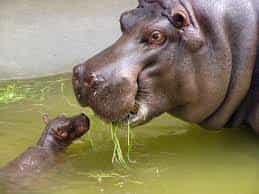Hippo Facts/ Amazing Facts of Hippo

Hippopotamus, commonly known as hippo, is a large,
herbivorous, semiaquatic mammal. There were two extant species in the family
Hippopotamidae, they are common hippopotamus or river hippopotamus and pygmy
hippopotamus. The Latin word “Hippopotamus” comes from the ancient Greek,
meaning “horse of the river”. Hippopotamidae also known as hippopotamids. It is
believed that Hippopotamidae have evolved in Africa. Kenyapotamus lived in
Africa around 16 million to 8 million years ago, which is possible ancestor of
living hippopotamus of Africa. Hippopotamid species slowly spread across Europe
and Asia bot they have ever been found in the Americas. Now hippos live in
eastern central and southern sub-Saharan Africa.
Hippos are the third largest land animal in the world, after
elephant and some rhinoceroses. Hippo has barrel-shaped body with four short
legs. Their skeletal structures help them to carry their enormous weight burden
when they are in water. Though, hippos are bulky animals, they can not jump but
can climb up steep banks. The average weight of a male hippo is 1600kg to 4000kg
and female is about 1400kg. They can grow up to 14 feet long and up to 5.2 feet
tall at the shoulder.
As they are semiaquatic animals, they have webbed feet
but yet they are not actually good swimmer and not can it float. They have a
big skull and on the high roof of the skull, their eyes, ears and nostrils are
placed, which help them to keep these organs out of the water surface while the
rest of the body submerges. During the day time, hippos immerse themselves in
water because staying out of water for a long time, their skin may crack or can
lead to dehydration.

Hippo has powerful jaws. They can open their mouth almost
180° because the jaw hinge is located far back enough. The male hippo’s canine
teeth and lower incisor teeth are enlarge and grow continuously and the canine
teeth reach up to 40 cm. These teeth are used for combat but not used in feeding.
Hippos have
broad horny lips which help them to grasp and pull the grasses and their molar
teeth help to grind the grasses. Their three-chambered stomach helps them to
digest the food but hippos do not chew-cud.
Hippos are grey to blue-black in colour but the color of their under
parts ,around the ears and eyes are pink. Hippo’s body has
less hair and the thickness of skin is 6cm which protects them from predator. Their skin secretes a red-coloured substance which is
referred as “blood-sweat” but it is neither blood nor sweat. This substance is
actually colourless but within minutes, it turns red-orange colour and slowly
becomes brown. In the secretion two pigments have been identified, red and orange.
Red pigment (hipposudoric acid) and orange (norhipposudoric acid), both
pigments are highly acidic compounds. These pigments protect the hippo from
pathogenic bacteria and act as sunscreen and antibiotic. These pigments also
regulate the body temperature of hippos.
A hippo can live 40 to 50 years. Dona the Hippo lived
at Mesker Park Zoo in Evansville, Indiana in the US, was the oldest living
hippo, died in 2012, at the age of 62.
Hippos spend the day time in the lakes and rivers and
can be found in Savannah and forest areas. At dusk, they leave the water and
travel inland up to 15km and spend 4 to 5 hours grazing 68kg of short grasses
each night. Short grasses are their main sources of food but they also eat
fruits.
In water, an adult hippo moves at speeds up to 8km/hr
and every 3 to 5 minutes, it resurfacing to breathe. An interesting fact is
that when the hippos sleep under the water, they rise to the surface of the
water and breathe without waking up. When they submerge into the water, they
close their nostrils.
Hippos are living
in groups with 30 animals and a group is called a pod, herd, dale, school or
bloat. Each pod has females, young and male hippos and led by a dominant male
hippo.

Every two years female hippo gives birth only one calf
under water. The weight of the new-born calf is between 25kg and 50kg and
average length is 127cm. Then the mother brings the calf up to the surface
within 40 seconds for its first breath. The calf rest on its mother’s back when
the depth of the water is high for the calf and suckle into the water as well
as land. Mother Hippo keeps her baby away from the others. This time mother hippo
remains separated from the herd, and stays with her calf for about 2 weeks and
then re-joins the herd. She nurses the calf for 8 months. Both male and female
hippos protect their baby from the predators like lions, hyenas and crocodiles.
When the calf is about 5 to 7 years old, it becomes fully mature.
Hippo is considered to be extremely aggressive,
dangerous and unpredictable animal. They can charge and attack humans and
boats. They can easily attack or drown small boats and can injure the passengers
or kill them. In 2014, in Niger, a hippo attacked a small boat filled with
Nigerian school children. 12 children and one teacher were killed by that
hippo. In Africa, about 500 people are killed by hippos in each year.
In the late 1980s, Pablo Emilio Escobar Gaviria was one
of the wealthiest criminal in the history. This Colombian drug lord kept many
animals included four hippos at his residence in Hacienda Napoles. In 1993, he
was killed by Colombian National Police. After his death all animals which he
kept in a private menagerie, sent to the zoo. But his four hippos made their
way into Colombia’s waterways. By 2007, the hippos had multiple to 16 and today
between 60 and 80. In 2009, two adults and a calf escaped the herd and attacked
the people and also killed the cattle. Then the hunters killed one adult who
was called Pepe.
Ward off enemies, hippo opens its big wide mouth and
display their teeth which is a warning against attack. Their jaws are so
powerful that they can cut a canoe in half with their jaws. When the hippos
feel threatened they shake their head, roar, grunt and make loud wheezing
sound.
Hippos face threat because of poaching and habitat
loses. Each year hundreds hippos being shot to keep them out of crops. Hippos
are killed by poachers for meat, fat and ivory canine teeth.
For a long time, hippo is considered a popular zoo
animal. Obaysch was the first zoo hippo at the London zoo on 25 May 1850. Every
day 10,000 visitors used to come to the zoo to see him and inspired a popular
song “Hippopotamus Polka” In 1987, the
Toledo Zoo was the first witness of the first underwater birth by captive
hippos.
Greek and Romans also know about the hippo. Greek historian Herodotus and Roman naturalist Plini the Elder wrote about the hippo in their writings.


.jpg)














0 Comentarios:
Post a Comment
Please do not use any abusing words or enter any spam links in the comment box